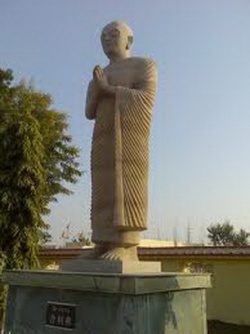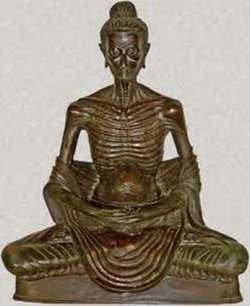Difference between revisions of "Niganthā"
m (Text replacement - "Category:Sanskrit terminology" to "{{SanskritTerminology}}") |
|||
| (3 intermediate revisions by one other user not shown) | |||
| Line 2: | Line 2: | ||
The name given to the {{Wiki|Jains}}, the followers of [[Wikipedia:Mahavira|Nigantha Nātaputta]]. Unlike the Acelakas, they wore one garment, a covering in front. But when praised for their modesty, they answered that their [[reason]] for wearing a garment was to prevent dust and dirt from falling into their [[alms]] dishes. For even dust and dirt are actual individuals and endowed with the principle of [[life]] (DhA.iii.489). | The name given to the {{Wiki|Jains}}, the followers of [[Wikipedia:Mahavira|Nigantha Nātaputta]]. Unlike the Acelakas, they wore one garment, a covering in front. But when praised for their modesty, they answered that their [[reason]] for wearing a garment was to prevent dust and dirt from falling into their [[alms]] dishes. For even dust and dirt are actual individuals and endowed with the principle of [[life]] (DhA.iii.489). | ||
| − | The chief [[precepts]] of the [[Wikipedia:Nirgrantha|Niganthā]] are included in the cātuyāmasamvara - the fourfold restraint (for their beliefs and practices see [[Wikipedia:Mahavira|Nigantha Nātaputta]]). The chief centres of the | + | The chief [[precepts]] of the [[Wikipedia:Nirgrantha|Niganthā]] are included in the [[cātuyāmasamvara]] - the fourfold restraint (for their beliefs and practices see [[Wikipedia:Mahavira|Nigantha Nātaputta]]). The chief centres of the Niganthā's, in the time of the [[Buddha]] , seem to have been [[Vesāli]] (e.g., J. iii.1; M.i.228) and [[Nālandā]] (M.i.371), though they had settlements in other important towns, such as {{Wiki|Rājagaha}} (e.g., at Kālasilā, on the slopes of Isigili, M.i.92). |
The chief patrons of the [[Buddha]] 's time were: | The chief patrons of the [[Buddha]] 's time were: | ||
| Line 12: | Line 12: | ||
[[Vappa]] the Sakyan in [[Kapilavatthu]] (AA.ii.751). | [[Vappa]] the Sakyan in [[Kapilavatthu]] (AA.ii.751). | ||
| − | The books contain several names besides that of Nātaputta of distinguished members of the | + | The books contain several names besides that of Nātaputta of distinguished members of the Nigantha Order - e.g., Dīgha-Tapassī, and Saccaka, and also of several women, Saccā, Lolā, Avavādakā and Patācārā (J.iii.1). |
The lay followers of the [[Wikipedia:Nirgrantha|Niganthā]]wore white garments (M.ii.244). | The lay followers of the [[Wikipedia:Nirgrantha|Niganthā]]wore white garments (M.ii.244). | ||
[[File:Ima789ges.jpg|thumb|250px|]] | [[File:Ima789ges.jpg|thumb|250px|]] | ||
| − | In the Chalabhijāti classification of | + | In the [[Chalabhijāti]] classification of [[Pūrana Kassapa]] , the [[Ekasātaka-Niganthas]] occupied the third rank, the red (A.iii.384). The [[Buddha]] condemned the [[Nigantha]]'s as unworthy in ten respects: |
#they were without [[faith]] , | #they were without [[faith]] , | ||
| Line 31: | Line 31: | ||
Their fast resembled a herdsman looking after the kine by day, which were restored to their owners at eventide (Ibid., i.205f). The Niganthas were so called because they claimed to be free from all bonds (amhākam ganthanakileso palibujjhanakileso natthi, kilesaganthirahitā mayan ti evam vāditāya laddhanāmavasena Nigantho) (E.g., MA.i.423). | Their fast resembled a herdsman looking after the kine by day, which were restored to their owners at eventide (Ibid., i.205f). The Niganthas were so called because they claimed to be free from all bonds (amhākam ganthanakileso palibujjhanakileso natthi, kilesaganthirahitā mayan ti evam vāditāya laddhanāmavasena Nigantho) (E.g., MA.i.423). | ||
| − | The [[Buddhist]] books record (M.ii.243f.; D.iii.117, 210) that there was great dissension among the | + | The [[Buddhist]] books record (M.ii.243f.; D.iii.117, 210) that there was great dissension among the Nigantha's after the [[death]] of Nātaputta at Pāvā. The Commentaries state (DA.iii.906; MA.ii.831) that Nātaputta, [[realizing]] on his [[death]] bed the folly and futility of his teaching, wished his followers to accept the [[Buddha]] 's teaching In order to bring this about, he taught his [[doctrine]] in two different ways to two different pupils, just before his [[death]] . To the one he said that his teaching was [[Wikipedia:Nihilism|Nihilism]] ([[uccheda]]), and to the other that it was Eternalism ([[sassata]]). As a result, they quarrelled violently among themselves, and the Order broke up. |
| − | That the | + | That the Nigantha's lasted till, at least, the time of [[Nāgasena]], is admitted (Mil..p.4) by the fact that [[Milinda]] , was asked to consult a [[teacher]] called [[Wikipedia:Mahavira|Nigantha Nātaputta]], who, if at all historical, was probably the direct successor to the [[teacher]] of the same name, contemporary with the [[Buddha]] . |
| − | There is evidence in the Jātakas to show that the | + | There is evidence in the [[Jātakas]] to show that the Nigantha Order was in existence prior to the [[life]] of the [[Buddha]] . Saccatapāvī, mentioned in the [[Kunāla Jātaka]] (J.v.427), is described as a [[setasamanī]], and may well have belonged to the Order of the [[Svetambara]]'s, while in the [[Mahābodhi Jātaka]] (J.v.246) mention is made of a [[teacher]] who is identified with Nigantha Nātaputta himself. |
| − | There seems to have been a settlement of | + | There seems to have been a settlement of Nigantha's in Ceylon from very early times. When Pandukābhaya laid out the city of Anurādhapura, he built also hermitages for several [[Nigantha]]'s - Jotiya, Giri and [[Kumbhanda]] (Mhv.X.97f). These continued to be inhabited even after the establishment of [[Buddhism]] in the Island, for we hear of them in the reign of Vattagāmanī (circa 44 A.C.). When Vattagāmanī pulled down the residence of the [[Nigantha]] Giri, because of his disloyalty to the king, he built on its site the [[Abhayagiri vihāra]]. (Ibid., xxxiii.42f.) |
{{R}} | {{R}} | ||
[http://what-buddha-said.net/library/DPPN/n/niganthaa.htm what-buddha-said.net] | [http://what-buddha-said.net/library/DPPN/n/niganthaa.htm what-buddha-said.net] | ||
[[Category:Buddhist Terms]] | [[Category:Buddhist Terms]] | ||
[[Category:Buddhist Philosophy]] | [[Category:Buddhist Philosophy]] | ||
| − | + | {{SanskritTerminology}} | |
Latest revision as of 12:31, 27 April 2014
The name given to the Jains, the followers of Nigantha Nātaputta. Unlike the Acelakas, they wore one garment, a covering in front. But when praised for their modesty, they answered that their reason for wearing a garment was to prevent dust and dirt from falling into their alms dishes. For even dust and dirt are actual individuals and endowed with the principle of life (DhA.iii.489).
The chief precepts of the Niganthā are included in the cātuyāmasamvara - the fourfold restraint (for their beliefs and practices see Nigantha Nātaputta). The chief centres of the Niganthā's, in the time of the Buddha , seem to have been Vesāli (e.g., J. iii.1; M.i.228) and Nālandā (M.i.371), though they had settlements in other important towns, such as Rājagaha (e.g., at Kālasilā, on the slopes of Isigili, M.i.92).
The chief patrons of the Buddha 's time were:
Sīhasenāpati in Vesāli,
Upaligahapati in Nālandā and
Vappa the Sakyan in Kapilavatthu (AA.ii.751).
The books contain several names besides that of Nātaputta of distinguished members of the Nigantha Order - e.g., Dīgha-Tapassī, and Saccaka, and also of several women, Saccā, Lolā, Avavādakā and Patācārā (J.iii.1).
The lay followers of the Niganthāwore white garments (M.ii.244).
In the Chalabhijāti classification of Pūrana Kassapa , the Ekasātaka-Niganthas occupied the third rank, the red (A.iii.384). The Buddha condemned the Nigantha's as unworthy in ten respects:
- they were without faith ,
- unrighteous,
- without fear and shame,
- they chose wicked men as friends,
- extolled themselves and disparaged others,
- were greedy of present gain,
- obstinate,
- untrustworthy,
- sinful in their thoughts ,
- and held wrong views (A.v.150).
Their fast resembled a herdsman looking after the kine by day, which were restored to their owners at eventide (Ibid., i.205f). The Niganthas were so called because they claimed to be free from all bonds (amhākam ganthanakileso palibujjhanakileso natthi, kilesaganthirahitā mayan ti evam vāditāya laddhanāmavasena Nigantho) (E.g., MA.i.423).
The Buddhist books record (M.ii.243f.; D.iii.117, 210) that there was great dissension among the Nigantha's after the death of Nātaputta at Pāvā. The Commentaries state (DA.iii.906; MA.ii.831) that Nātaputta, realizing on his death bed the folly and futility of his teaching, wished his followers to accept the Buddha 's teaching In order to bring this about, he taught his doctrine in two different ways to two different pupils, just before his death . To the one he said that his teaching was Nihilism (uccheda), and to the other that it was Eternalism (sassata). As a result, they quarrelled violently among themselves, and the Order broke up.
That the Nigantha's lasted till, at least, the time of Nāgasena, is admitted (Mil..p.4) by the fact that Milinda , was asked to consult a teacher called Nigantha Nātaputta, who, if at all historical, was probably the direct successor to the teacher of the same name, contemporary with the Buddha .
There is evidence in the Jātakas to show that the Nigantha Order was in existence prior to the life of the Buddha . Saccatapāvī, mentioned in the Kunāla Jātaka (J.v.427), is described as a setasamanī, and may well have belonged to the Order of the Svetambara's, while in the Mahābodhi Jātaka (J.v.246) mention is made of a teacher who is identified with Nigantha Nātaputta himself.
There seems to have been a settlement of Nigantha's in Ceylon from very early times. When Pandukābhaya laid out the city of Anurādhapura, he built also hermitages for several Nigantha's - Jotiya, Giri and Kumbhanda (Mhv.X.97f). These continued to be inhabited even after the establishment of Buddhism in the Island, for we hear of them in the reign of Vattagāmanī (circa 44 A.C.). When Vattagāmanī pulled down the residence of the Nigantha Giri, because of his disloyalty to the king, he built on its site the Abhayagiri vihāra. (Ibid., xxxiii.42f.)

